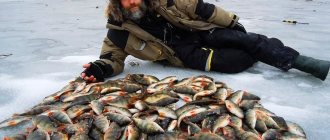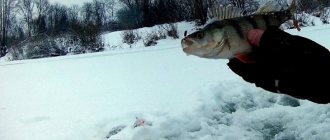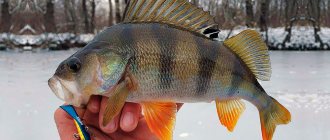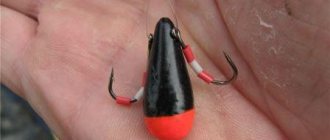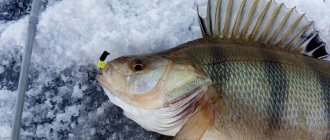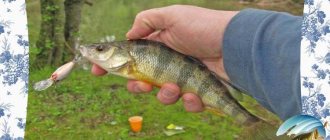Content
- Perch Fishing - A Quick Guide
- A little theory
- How to catch perch in winter
- How to catch perch in open water
- Float tackle
- Spinning
- Share your experience and increase your knowledge
He is omnipresent. He is gluttonous, omnivorous and brave. But as soon as you get ready to purposefully catch the “striped fish,” he becomes picky, timid, and “in general, the pressure increases and the weather changes.”
Features of perch fishing at the beginning, middle and end of summer
In June
At the end of May - beginning of June, perch occupies summer habitats : small and medium sized ones occupy coastal thickets and well-warmed shallow waters, and large ones are located in holes away from the shore.
Fishing for perch in July using a spinning rod
July is perhaps the worst time for a spinner . Many predators at this time refuse to respond to bait at all. In contrast, perch remains active, but one cannot count on large catches.
Perch Fishing - A Quick Guide
Let's try to summarize the existing experience of amateurs and professionals, and then try to establish patterns that will help find this fish and catch it. Technical means of photo-video recording will help us with this, which open up new opportunities: to look at the process from the side of the fished object, to better understand the habits of the fish and to notice our own mistakes and shortcomings. Due to the wide distribution of this species in our reservoirs and the many different ways of catching it, we will consider winter and summer fishing separately.
A little theory
Before moving on to practical advice “Where?”, “When?” and “How to catch perch?” I suggest you familiarize yourself with the theory a little. Many spears and fishing rods have been broken in scientific discussions about whether to divide the species of river perch (Perca fluviatilis., lat.) into separate subspecies: “deep” - large, predatory and “coastal” - small, omnivorous. Official science has adopted the following postulate: “river perch forms two different ecological forms, or races, which differ in habitat, diet and growth rate.” Moreover, at the first stages of development, these forms live and feed together in the coastal zone, and then are divided according to the type of nutrition and localization in the reservoir, which introduces additional confusion into the taxonomy.
The coastal form prefers to stay in flocks in small creeks with a slow current, near bridge supports, piles, flooded bushes and snags. Small dumps, aquatic vegetation and stones provide them with shelter from predators and hunting grounds. The diet consists of insect larvae, zooplankton, fry, and worms.
Large perch (in the slang of site visitors, “humpbacked” or “sea”, as opposed to coastal - “sports”) lives at considerable depth, in whirlpools and channel holes, which it leaves only for hunting. It usually gathers in small flocks only during the feast. It feeds mainly on small fish, shellfish, etc. However, this division is very arbitrary. For example, I had to catch respectable specimens weighing up to 1.5 kg from the shore with a fishing rod using a worm, and on a spoon, at a depth of 6-8 m, it happened that specimens hardly larger than the bait itself landed.
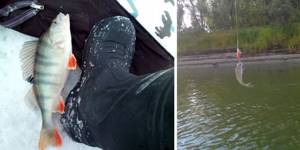
The behavior of this fish largely depends on the time of year. In the spring, after spawning, perch migrates to the mouths of rivers and streams and can rise upstream in search of food. Doesn't bite well in muddy water. As the water level drops, it rolls down to its main habitat. In summer and autumn, it actively feeds both in deep and shallow water, gathering in huge flocks. Finding such a “boiler” is a great success for a fisherman. Driven by instinct, the perch greedily pounces on any offered bait, trying to get ahead of its fellow tribesmen. This continues until freeze-up.
During the first ice, perch is usually better caught with a spoon and a balance beam; in the dead of winter it can be almost passive, but there are times when the fish bite on insect larvae, zooplankton or baits that imitate them. Ichthyologists explain this by the fact that caviar or milt, at this time, occupy most of the abdominal cavity of the fish, and it is physically unable to swallow large objects.
Read about catching winter perch using a balance beam in our article. It reveals fishing techniques, tactics, which balancers are best to fish with and much more.
Spring
In the spring, when the ice has moved several meters from the shore and the water temperature is low, the perch is passive. But it is possible to provoke him by aggressively playing with silicone tips. The striped predator stays far from the shore. The most productive fishing in early spring occurs in cloudy weather in the middle of the day.
As soon as the water warms up somewhat, the perch moves to shallow water, feeds heavily on small fish and prepares for spawning.
Bites occur at shallow depths close to the shore. This period is ideal to meet a trophy specimen. But during spawning there is no point in going out hunting.
By the end of April, it is possible to resume going out on the water. The fish is especially hungry because... restores strength. It bites unevenly and appears chaotically several times during the day.
For perch, the weather is not particularly important; it reacts more to the water temperature. The warmer the water, the more willingly the striped bully responds to the fisherman's play.
At the end of May, the perch changes behavior. He is no longer so hungry, he has eaten fat, the fish scatter throughout the reservoir and move to new points.
Wobblers are exactly the bait that perch bites on in the spring. The rod itself should be comfortable. The reel is compact. Spoons of the type are rotating, oscillating, silver, 4-6 cm long. Since the favorite habitats of the predator are those where the bottom is littered with snags and grass, fishing has some difficulties.
The bait may get caught. But at the same time, the catch in such places will be serious. The ideal place for fishing is an open reservoir with vegetation around, the depth is average.
During this period the fish are close to the shore, so there is no need to fish from a boat. The predator is very active, large specimens are located approximately 3m from the shore.
How to catch perch in winter
How to catch perch in winter - this question is not as simple as it seems at first glance. It would seem, what does it take to catch a perch?
- Decide on a body of water
- Choose a fishing method
- Choose bait and groundbait
- Prepare winter equipment
- Find a place... and catch...
But perch is unpredictable and capricious, it bites on everything, but “yesterday and tomorrow.” Let's say that in the summer on a pond he immediately knocks down a worm that you put on a hook and spat on in the hope of catching a crucian carp. And in winter, this very pond is as quiet as a swimming pool. It happens that in the morning he aggressively attacks the balancer, at noon he prefers live baits, and in the evening he becomes passive and ignores any tricks of the angler. Therefore, having decided on a body of water, you need to come there fully armed and search.
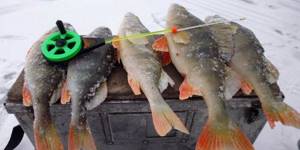
An undoubted advantage of winter fishing, compared to summer fishing from the shore, is the wide possibility of maneuver in choosing a fishing point. Professional fishermen recommend choosing a point based on your own preferences and knowledge of the habits of the fish. The first thing you need to do is find the perch; to do this, you should drill several holes (5-10-20 pieces) using the square-cluster method at different depths, feeding them at the same time. Small bloodworms are usually used as bait.
By the way, in under-ice footage, we often observe that the perch only moves towards the feeding spot, but is in no hurry to eat the bait.
Although it also happens that the fish, like an industrial vacuum cleaner, collects complementary food, but does not pay any attention to the limply dangling jig. Therefore, whether to feed or not is up to you.
Then, when you are thoroughly tired of drilling, you should return to the first hole, and then check everything in order, making several strokes of different intensity and amplitude in each, until a bite appears. More details about how to look for perch in winter are described in this video:
If the bite does not occur, try changing the bait or tackle (experienced fishermen have several equipped fishing rods with different jigs in their fishing box, so as not to tie them in the cold). A review of jigs for perch can be found in this article.
The food preferences of fish can change several times a day. Therefore, in the arsenal of a fan of winter perch fishing there should be spoons, and balancers, and baitless jigs and live baits in an assortment (bloodworms, jigs, maggots) and, of course, “tea with sandwiches” to keep warm and while away the time without biting.
Large perch on the river are looked for under a steep bank, in holes, in quiet places with a slow or reverse current, near flooded trees. The “humpback” is caught mainly with a balancer, rattlin, or spinner.
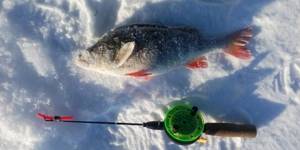
In such places, the chance of catching a trophy specimen increases, but the likelihood of losing the balancer increases proportionally because vertical wobblers do not move in a straight line, but along a more intricate trajectory. To reduce the loss of bait, anglers bite off the front or rear hook of the balancer and the number of hooks is slightly reduced. Spoons, in my blinkered opinion, are less catchy, although I knew specialists who mowed down dozens of two-kilogram perches in Berdsky Bay with homemade spoons, however, in those days the trees were taller and there were more fish.
Pike can also stand in holes with snags, so it is recommended to use a short (up to 10 cm) leash.
Perhaps I won’t reveal a big secret if I formulate the principles of winter perch fishing as follows: “Move a lot, drill a lot, experiment more often with gear, bait and the method of their animation.”
Perch habitats
Striped representatives of the predatory perch family prefer small fish and other living creatures in their diet. Therefore, the location of its appearance can be detected by such a characteristic feature as large accumulations of small fish.
Schools of small fish, in most cases, like to be located in shallower areas of reservoirs; in addition, a clear sign of the presence of perch in a reservoir is the appearance of seagulls and other birds of prey that circle over places where small fish accumulate, for which the striped predator is hunting.
If you want to catch larger representatives of the striped family, then you should look for these individuals in deeper parts of the reservoir; in addition, these individuals can be located around the supporting pillars of the bridge; they love accumulations of all kinds of snags and fallen trees.
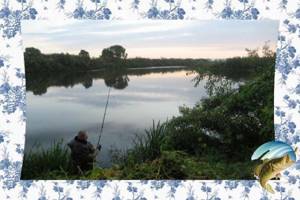
In addition, representatives of the striped family like to hide in the vast thickets of various vegetation of the reservoir, actively hunting for unwary representatives of smaller fish.
On rivers with fast currents, striped individuals can be located directly next to the main stream of the current, carrying out processes to monitor small fish. During periods when it is unbearably hot outside, striped predators prefer to go into deeper parts of the reservoir, hide in bushes and thickets, and hide in the rubble of fallen trees.
How to catch perch in open water
I love summer fishing more. It's warm in the summer. Even if it doesn’t bite, you can sit on a log by the fire, or just lie on an overturned boat and look at the starry sky above your head, wondering and awe, like old Kant. True, he also wove something about the moral law inside, but inside you there is only a hot dinner and a warm drink that makes you crave for philosophical reasoning. As soon as you close your eyes, visions of your day’s experiences emerge: a float swaying on the water or the tip of a spinning rod. When bitten, the muscles contract sharply, and you shudder, just like a sleeping dog “runs” and whines in its sleep...
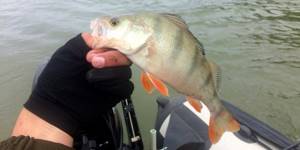
In the morning, at sunrise, you need to be near the water. Perch is a light-loving fish; at dawn it gathers in schools and goes out hunting, which can last until dusk. By evening, the flocks scatter, and each individual, hiding somewhere, freezes until dawn. At night, the perch does not feed or bite; this is pike perch time.
Float tackle
You can catch perch using a float rod. The bait usually used is a worm, maggot, bloodworm, and fish slices. Bottom gear is usually used when fishing with live bait. Just like in winter, you need to look for perch in the pond. On large lakes and reservoirs, if you have a boat, seagulls will help you find the “cauldrons”; they circle above the water, hoping to profit from the place where the predator drives schools of small fish to the surface of the water. Don't yawn here. It’s damn nice to sit with a fishing rod on the shore, tug on the fish on your rightful day off, but, in my opinion, this is still the lot of boys, vacationers and retired summer residents.
Fishing methods, gear and equipment
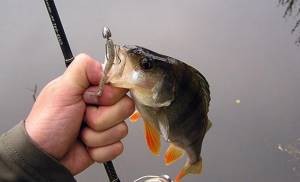
Despite the fighting qualities of the fish and the aggressiveness of the bites of the gear for catching it, they do not require a special approach to strength. Due to the relatively small size of the trophy, and the capture of a kilogram humpback whale is already considered a solid result, ordinary and lightweight gear is used for fishing. When you have to catch perch in snag conditions, it is recommended to use stronger braided lines. In clear water conditions, monofilament up to 0.25 mm will be sufficient.
The most widespread are the spinning, float and bottom fishing methods. The principle of collecting gear is not radically different from the classic equipment in each type of the above fishing methods, but the narrower specificity of finalizing some aspects of installation allows you to add sensitivity and subtlety to the gear in transmitting tactile and visual sensations to the angler when biting. Perch fishing weather with windy days makes it necessary to switch to bottom gear. On calm, fine days, hunting with an ultra-light spinning rod and float tackle is more enjoyable. During the freeze-up period, light winter spinning rods with a monofilament and an inertial reel are used, and to use jigs, the fisherman resorts to small and medium-class winter fishing rods, so-called balalaikas in winter roads, using mono fishing lines with diameters from 0.06 to 0.1 mm. Let's look at the most common fishing methods, delving into the nuances of equipment and technique for performing each method.
How to properly catch perch using bottom tackle

Bottom tackle can be used in several types, making allowances for the fishing season. In autumn and spring, a rubber band and bottom fishing equipment mounted on a spinning rod or feeder rod are used. I catch perch in the summer rationally and conveniently with a walking bottom mounted on a fly rod. The first two types of donks are made in their classic version, on a base of braided cords using fishing line leashes no more than 50 cm.
Important! Hooks are used with a long shank, since aggressive fish swallow other hook options whole, taking the fisherman considerable time to remove it from the insides of the trophy.
The gear is installed in clean water areas, both with and without current. The most common bait is inert baits of animal origin, worms and insect larvae. The predator's bites are sharp, with the caught bait retreating to depth. The hyperactivity of a fish when biting always leads to its inevitable self-cutting. Fishing requires caution, since sudden movements can lead to rupture of the fish’s lips, the structure of which is pampered by the physiological characteristics of the predator. Catching perch in summer in vegetation windows allows you to use a walking dock, when a piece of monofilament with a weight and a hook is attached to a fly rod.
The bait is bait of any type of fish. Moving along the coastline, the fisherman places bait in clean areas between the vegetation, leaving it for a couple of minutes. If the predator is active, then the fry is attacked, but if not, then another place is fished.
How to catch perch with a spinning rod
Perch baits for spinning fishing are miniature and not weighty in their overall dimensions, which requires the use of perch fishing techniques with ultra-light tackle. Ultrik is equipped with a lightweight spinning line, with a friction clutch and a small spool that can hold about one hundred meters of braided fishing line 0.08-0.1 mm in diameter. It is recommended to tie artificial baits in the form of a wobbler, spinner or silicone fish for microjig directly to the cord, which allows you to avoid rough installations.
Lures are delivered to promising fishing spots and animated using jerky, stepped and uniform retrieving. Any resistance of the bait requires a smooth, unhurried hooking motion. Unforced fishing with the selection of a trophy in a landing net guarantees a positive outcome of the bite. They fish with a spinning rod both from the shores of a reservoir and from a boat, approaching the boilers and places where the fry are washed out at shorter distances. After five or seven trips, in the absence of bites, but the presence of fish is visually guaranteed, the bait is changed to another type or color, continuing to experiment with wires and depth levels until a positive result is obtained.
How to catch perch with a float rod
It is preferable to use float rigs for catching perch in the spring, during the feeding period, when the fish come closest to the shore, becoming less cautious than in other periods. The rods are equipped with monofilament fishing line no thicker than 0.25 mm, using stationary non-slip floats of 2.5 -5 grams.
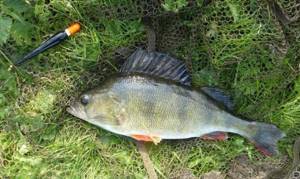
A universal form or a spindle form are the most practical options for signaling devices. Depending on the method of catching perch, from the bottom or in the water column, a shipment of equipment is carried out, using lead pellets of different sizes for these purposes. The installation is completed with a leash from 0.15 to 0.2 mm no longer than 25 cm and a hook with a long shank according to the size of the expected catch. A bite is determined by the complete flooding of the float, which requires a gentle pull of the rod towards you and subsequent leisurely landing of the fish.
Spinning
For most people, the greatest emotions come from catching perch with a spinning rod. Here you need to outwit the fish, slip it an absolutely inedible object, make it play so that it would mistake it for food, and in the end it would become the victim itself. This is the next step in the evolution of the fisherman. Spinning means a larger selection of baits, greater freedom of action and the widest field for experimentation.
When fishing for perch, silicone is used in different ways: from classic vibrotails, medium-sized twisters and worms to completely hallucinogenic fantastic creatures, the advertised catchability of which I personally have not been convinced of. In terms of catchability of perch and versatility of use, the retractable method of installing “silicone” gear is in first place for me. But, ultimately, the result depends on the specific fishing conditions. In thickets of grass, the best results may be shown by a Carolina and Texas hook, or a slightly loaded offset hook; in shallow water - a micro jig or bombard; in the depths - perhaps a jig and a drop shot. But you should not take this statement as an axiom; you need to look for the optimal solution yourself.
Other people's experience will not be superfluous. This video, for example, will be useful for those who are interested in fishing with a Carolina rig.
Let's consider another aspect of spinning fishing for perch - fishing with a wobbler. More often, this method justifies itself in shallow and medium depths, as well as when catching fish that hunt in the water column or near its surface. The choice of baits is great: classic wobblers, poppers, walkers, rattlins - almost all of them have their advantages, but are not without their disadvantages. Anyone who wants to plunge headlong into a topic, learn a lot of different opinions and gain practical knowledge - welcome to our forum. Here is one of the discussions: “Reviews of wobblers, fishing techniques.”
With spinners, everything is somewhat simpler. For beginners, I would recommend a classic spinner from number zero to number four. You will have to experiment with the color, depth and speed of the spinner in each specific case. If you start with Chinese fakes, you can quickly become disappointed in lure fishing.
When does perch bite in spring?
Perch is incredibly voracious and feeds all year round. There are only two moments in its life when catching it is problematic: spawning, which lasts about 2 weeks, and about a week after the reservoir is freed from ice.
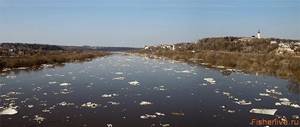
The rest of the time, perch can be successfully caught using any gear. A week after the ice melts, the perch begins to actively feed before spawning. Perch spawning is very unusual and depends on several conditions:
- Warming up the water to 7-9 degrees
- The beginning of the water decline
Any fish spawns at a certain temperature at which the eggs can develop. The decline in water is very important, since the perch lays eggs on underwater vegetation, and therefore the perch is afraid that the eggs will remain on the shore. Usually in the middle zone the spawning period coincides with the beginning of birch leaves blooming.
After spawning, the perch begins to feed heavily. This moment usually coincides with the period when the rosehip color begins to fall off, and lasts about a week. After the zhora, the perch begins to slowly move to summer parking areas and remains there until autumn.
Share your experience and increase your knowledge
In the review, we only tried to show novice fishermen that perch fishing is very interesting and exciting, and the wide distribution and unpretentiousness of this species allows them to experiment and practice on any body of water. You need to contract this incurable disease, try, make mistakes and try again, despite dogma.
I ask “chronic” fishermen not to blame the superficiality of the presentation, but, if possible, to share their experience and their “secrets” of finding and catching perch in the comments. After all, knowledge has value only if it is passed on and used by the next generation. This is progress and evolution. Then, maybe, young people will put down their gadgets and pick up a drill, a spinning rod and a box of maggots from our weakening hands!



